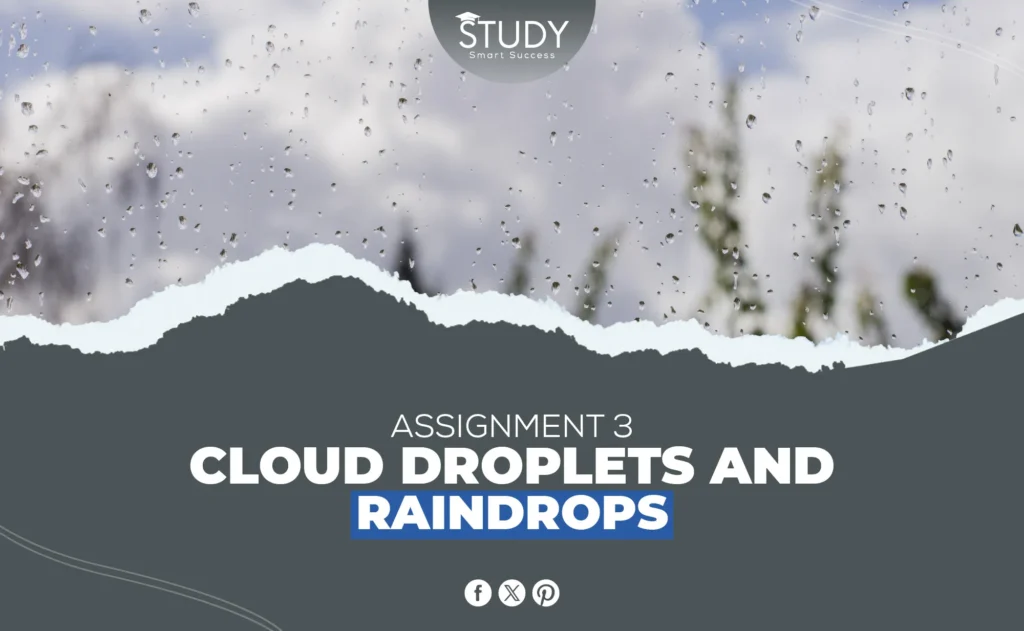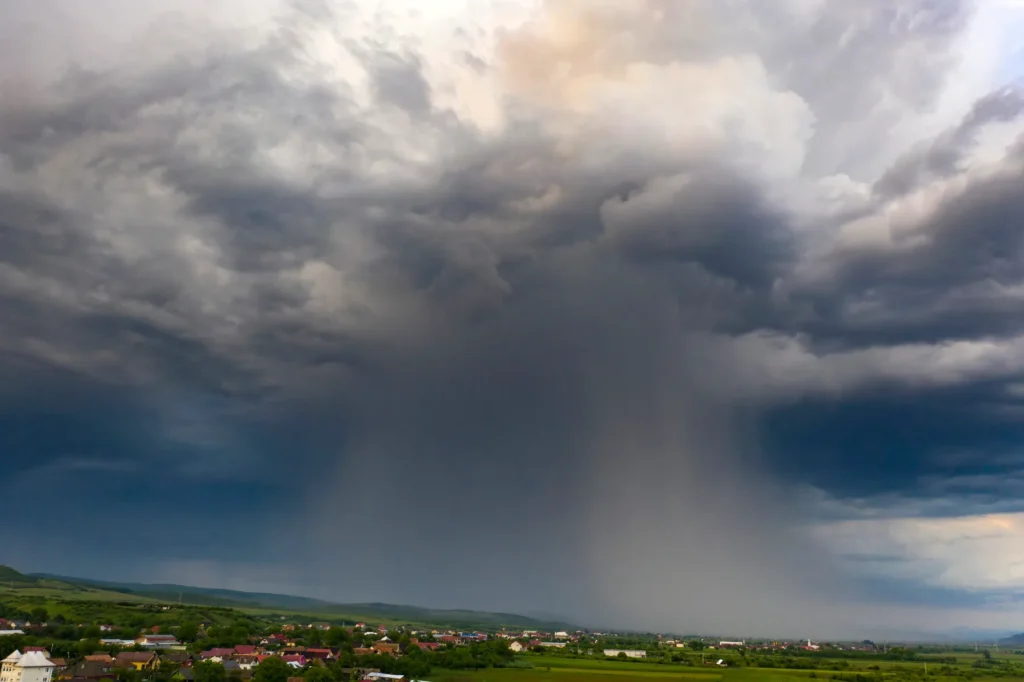Unveiling the Wonders of the Atmosphere
Introduction
Embark on an expedition into the celestial domains, where rainfall and cloud particles gracefully intertwine. This assignment requires us to explore the complexities of these phenomena, including their formation, the underlying scientific principles, and the critical ecological function they serve.
For Professor Garlick’s Assignment 1.
Brief Overview of Cloud Droplets and Raindrops
Clouds illuminate the sky with hypnotic formations consisting of airborne minuscule water particles. Cloud droplets ultimately transform into raindrops, which provide vital precipitation on the Earth’s surface.
Importance of Studying Cloud and Rain Formation
Clouds and rain, which may appear to be temporary phenomena in the atmosphere, possess immense importance when viewed through the lens of the planet’s ecosystems and climate. Comprehending the processes involved in the development of clouds and precipitation is not solely an academic undertaking; it is an imperative undertaking with significant ramifications. To provide a concise synopsis of the significance:
Water Cycle and Hydrological Balance:
It is essential to fathom the water cycle, the intricate process by which water moves between the atmosphere, land, and oceans, to have a foundational understanding of cloud and rain formation. This comprehension is crucial to upholding hydrological equilibrium, regulating freshwater accessibility, and preserving ecosystems.
Climate Control:
The function of clouds in regulating the Earth’s climate is crucial. Temperature patterns are altered through the reflection of sunlight into space. As a result of cloud processes, precipitation influences regional climate conditions and aids in the global distribution of heat. It is crucial to examine these processes to forecast and address climate change.
Agricultural Productivity:
Rainfall plays a crucial role in determining agricultural productivity. Scientists can enhance the accuracy of precipitation pattern forecasts by examining the formation of clouds and rain, thereby assisting farmers in optimizing insect management, crop scheduling, and irrigation techniques. Conversely, this results in increased agricultural productivity and nutritional security.
Weather Prediction and Disaster Preparedness:
A comprehension of cloud dynamics enhances the precision of meteorological forecasts. This information is vital for early warning systems, enabling communities to prepare in advance for severe weather phenomena like cyclones, hurricanes, or floods. Enhanced prediction capabilities aid in the reduction of the detrimental effects that natural catastrophes have on both human lives and infrastructure.
Ecosystem Health:
The patterns of precipitation have an impact on the health of various ecosystems. Arid deserts and tropical rainforests are influenced by the timing and availability of rainfall, affecting plant and animal life. Cloud and precipitation formation research offers valuable insights into these ecological interconnections, which support conservation initiatives and biodiversity administration.
Atmospheric Composition and Air Quality:
Rain and clouds both contribute to the purification of the atmosphere. Particulate matter and pollutants can be eliminated by precipitation, thereby contributing to enhanced air quality. It is critical to comprehend how pollutants and clouds interact to effectively mitigate the effects of human activities on air composition and address environmental challenges.
Scientific Innovation and Technological Advancements:
Scientific investigation into the formation of clouds and precipitation propels technological progress and innovation. It promotes the advancement of modeling tools, observation techniques, and instruments that enhance our comprehension of atmospheric phenomena and find wider utility in meteorology, climatology, and environmental science disciplines.
Fundamentally, the investigation of cloud and precipitation formation serves a purpose beyond mere elucidation of celestial enigmas; instead, it imparts knowledge that has the potential to revolutionize our approaches to planet management and interaction. Beyond scholarly inquisitiveness, this research holds significance in that it impacts resource allocation, policy formulation, and our shared obligation toward a sustainable future.
Purpose of Assignment: Exploring the Science Behind Clouds and Precipitation
We aim to clarify the scientific principles underlying clouds and precipitation by deconstructing the mechanisms by which imperceptible vapor becomes concrete droplets.
The Formation of Cloud Droplets
Atmospheric Conditions Conducive to Cloud Formation
Particular atmospheric conditions—a delicate interplay of temperature, humidity, and air currents—are the precursors to cloud formation. The article on atmospheric conditions offers a more comprehensive analysis of this complex choreography.
Nucleation Processes in the Atmosphere
Nucleation, an intriguing phenomenon characterized by the miraculous conversion of water vapor to liquid, is subject to the influence of numerous atmospheric particles. Investigate the nucleation mechanisms that modify cloud particles.
Factors Influencing the Size and Distribution of Cloud Droplets
Cloud particle size and distribution are not coincidental. Examine the determinants of these attributes and their ramifications on meteorological patterns.
The transition from Cloud Droplets to Raindrops
Collisions and Coalescence Mechanisms
As cloud particles collide, they grow and eventually transform into raindrops as larger entities—an exploration of the complexities of coalescence and collision mechanisms in raindrop formation.
Bergeron Process and the Formation of Ice Crystals
Subzero atmospheric regions are reliant on ice crystals for the formation of raindrops. Gain knowledge regarding the Bergeron process and the intricate realm of ice crystal formation.
Raindrop Development via Collision and Condensation
The transformation of cloud particles into rainfall entails an ongoing progression of expansion via collision and condensation. Explore the scientific rationale for this development phenomenon.
The Function of Aerosols in the Formation of Clouds and Rain
Varieties of Aerosols and Their Influence on the Formation of Clouds
Aerosols, which are airborne microscopic particulates, regulate cloud formation. Examine the various categories of aerosols and their function in forming clouds.
Comparison of Anthropogenic and Natural Aerosol Sources
Aerosols discharged into the atmosphere due to human activities influence cloud formation. Study the differentiation between anthropogenic and natural sources and the resulting implications.
The Impact of Composition and Size of Aerosols on Precipitation
The composition and magnitude of aerosols are significant. Examine the impact that aerosol size and composition variations have on precipitation patterns.
Techniques for Measurement and Analysis
Instruments Employed in the Examination of Cloud and Raindrop Properties
Using scientific instruments, the world of clouds and precipitation can be observed. Investigate the instruments utilized in the study of their properties.
Remote Sensing Technologies for Observation of the Atmosphere
Remote sensing technologies provide an expanded viewpoint. Gain knowledge of the remote sensing technologies utilized in studying the atmosphere.
Techniques for Extracting Critical Parameters via Data Analysis
It is essential to analyze massive datasets to derive meaningful information. Determine the data analysis techniques utilized in cloud and raindrop studies to extract crucial parameters.
Case Studies
An Analysis of Particular Meteorological Occurrences and Their Cloud-Rain Dynamics
Weather phenomena that occur in the real world offer invaluable insights. Investigate case studies that analyze the cloud-rain dynamics of particular meteorological occurrences.
Practical Implementations of Cloud and Raindrop Investigations
The insights derived from investigations into clouds and raindrops possess pragmatic implications. Examine the practical implications that affect various sectors and routine existence.
Consequences for Climate Research and Prediction Models of the Weather
The study of clouds and raindrops enriches climate research and weather forecasting. Comprehend the ramifications of this research about forecasting forthcoming weather patterns.
Obstacles and Forthcoming Pathways
Existing Constraints in the Investigation of Clouds and Raindrops
Notwithstanding progress, obstacles endure in the investigation of clouds and precipitation. Analyze the existing constraints and challenges encountered by researchers.
If you have any queries about this assignment, visit Assignment 3 – Cloud Droplets and Raindrops Answers.
Emerging Methods and Technologies
Technological progress is accelerating. Consider the novel approaches and emergent technologies that can potentially transform the cloud and raindrop research field.
The Significance of Raindrop and Cloud Droplet Research in the Study of Climate Change
It is crucial to perceive cloud and precipitation formation to grasp climate change. Explore the influence of research on cloud droplets and raindrops on advancing climate change studies.
Applicability in Practice
Effects on Water Resources and Agriculture
Rain and cloud research has implications for water resources and agriculture. Determine the effects on water availability, crop yields, and sustainable practices.
Significance in Industries Affecting Aviation and Weather
A precise weather forecast is vital for the aviation and weather-related sectors. Examine how cloud and precipitation research improves safety and productivity in these industries.
Stakeholder Benefits of Understanding Raindrops and Clouds
In the end, comprehension of clouds and precipitation is advantageous for society. Learn how this understanding impacts environmental sustainability and societal well-being.
Conclusion
In summary, our investigation into the domains of precipitation and cloud particles has revealed the complex mechanisms that influence our surroundings and climate. Gaining comprehension of these phenomena enables us to equip ourselves with the means to confront the obstacles posed by a shifting climate, guaranteeing a sustainable future for posterity. Appreciate the splendour and intricacy of the atmosphere, wherein each cloud and precipitation narrates a narrative of the magnificent design of nature.





